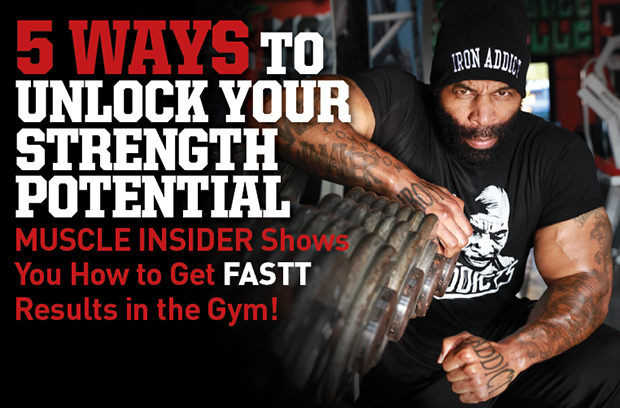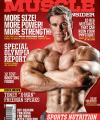5 WAYS TO UNLOCK YOUR STRENGTH POTENTIAL

MUSCLE INSIDER Shows You How to Get FASTT Results in the Gym!
If you want to get stronger and maximize your strength potential, keep reading because I’m going to go deep into the five key elements that are required to unlock your full strength potential. We are all strong, but we have the ability to be so much stronger than we realize. Some people are genetically born stronger than others, and then some people work on qualities and put in the work day in, day out to become stronger than everyone else. Strength is a skill, and the way to maximize a skill is through practice and working on your craft. I’m going to share with you five elements that will help unlock your strength potential and help you get stronger no matter what your current strength level is. Over my 20-plus years of competing and coaching, I’ve coached thousands of athletes from all ranges of age, strength, and competition. I’ve coached brand new lifters who have never touched a barbell, all the way up to National record holders and world medal powerlifters.
As well, I’ve used these same five principles in my own training to create a system that works for everyone, no matter their lift and no matter their level of training experience. What that means is that it doesn’t matter if you’re new to lifting weights or you’ve been lifting for years; these five keys are vital to your success and unlocking your strength potential.
I call these five elements the FASTT strength system.
You can use the FASTT system for any lift, for any exercise, and for anything you do lifting in the gym to maximize your lifting and unlock your full strength potential. If you’re ready to maximize your strength and take your training to another level, I advise you to not only read this article but also write and take notes. Something magical happens when the mind reads something and then you write it down. Grab a pen and a piece of paper and let’s get ready to unlock your true strength potential. My FASTT system is an acronym broken down into five easy-to-read, easy-to-understand letters. Each letter stands for a word that has true value to me in the gym. It doesn’t matter if it’s powerlifting, Olympic lifting, bodybuilding, or something else, this FASTT system can be applied to all strength endeavors.
The first letter in the FASTT system is F.

F: Focus
I can’t stress the importance enough of focus when you train and lift weights. We live in a world of distraction; every second, our mind and our focus is being grabbed and pulled in many directions: cell phones, texting, social media, apps, advertising, and more.
You may be more distracted than you realize. I’ve read that the average human attention span is approximately eight seconds, and I’m sure for teens and kids it’s even worse. This is why when I coach, before we even put a barbell in our hands, I preach that our number one focus needs to be exactly that one thing—focus.
You need to be present, and you need to not be distracted when you’re lifting weights and trying to get stronger. Put down your cell phone. Shut off your social media. Don’t look at your tablet. Focus. When you’re lifting weights and trying to get stronger, the only thing that should be on your mind is the task at hand. When you lose focus (and you will, often), you need to constantly bring your mind back to the task at hand. This may be very difficult at first, but as you practice your lifting, you can also practice your ability to focus. If your wind wanders 100 times, bring it back to focus 100 times.
“The successful warrior is the average man, with laser-like focus.”—Bruce Lee
A: Attitude
Your attitude in your training and lifting will play a huge role in your success, or lack of success. But first, let’s be clear about what I mean by “attitude.” The definition of “attitude” is “The way you think and feel about someone or something. A feeling or way of thinking that affects a person’s behaviour. A way of thinking and behaving that people regard as unfriendly, rude, etc.” To me, to have “attitude” in the gym means you act with mental and physical confidence. Attitude isn’t cockiness or arrogance; there’s a big difference. You can have a very confident and positive attitude and not be cocky or arrogant. When you start your workout, approach it with confidence. Enter the gym in a positive state of mind and leave any negativity at the door. At my gym, Heavy Weights Training Center, our number one rule for all our athletes and team is “no negativity.” Our gym is a protected house where negativity or negative thinking isn’t allowed. You must approach the gym or your place of training with a positive attitude. Once you start lifting, your mind-set must be trained to have a positive outlook. For example, let’s say you’re doing deadlifts and there’s some serious weight in front of you. Generally, there’s an immediate mental reaction to this. It can be something like “Damn, this is going to be heavy” or “I don’t think I can lift that.” You must train your mind to not allow thoughts like this to occur, and if they do, you must lean to flip it. You have to approach every set, every rep, every workout with PMA (positive mental attitude) and a positive attitude. Remember, approach every set and every rep with positive attitude, but know the difference between attitude and cockiness.
“When you’re good at something, you’ll tell everyone. When you’ re
great at something, they’ll tell you.”—Walter Payton

S: Set-Up
If you want to maximize your strength potential, it’s important that you learn and understand the importance of “setting up” a lift. The strongest lifters understand the importance of setting up their lifts. Strength is a skill, and you get stronger by practicing your lift and refining your skills, and one of the most important skills is learning how to set up for a lift. The set-up process can make or break a good lift. I always compare the set-up process to using a bow and arrow. If you had only one chance to hit the bull’s-eye, would you just draw back the arrow and fire, or would you take your time, create tension in the drawstring, and line up the arrow with the target perfectly, taking your time to make sure that one shot is as perfect as it can be? You wouldn’t just pull back the string and fire; you would take your time to make sure everything is perfect before you send the arrow to its target, and hit the bull’s-eye as perfectly as you could. The same thing can be applied to your set-up. You want to set up as perfectly as possible. Going through a set-up allows you to get your body and your mind ready to make the lift perfect. Lifting isn’t just about strength; it’s also about many other factors, which leads into our next very important key for maximizing your strength potential, and that’s technique.

T: Technique
If there’s one thing I see far too often when it comes to lifting and strength, it’s that most people don’t spend enough time practicing and working on their technique. Proper technique is of the utmost importance when lifting weights and trying to unlock your strength potential. Most people who train just focus on how much weight they lift, not how they lift the weight. The iron is always the best teacher, and sooner or later, if you don’t lift weight with proper form and technique, the iron will teach you a lesson. It doesn’t matter if you’re deadlifting 135 pounds or 585 pounds, the goal should always be to lift weight with perfect technique and form. Technique and form lay the groundwork for the development of strength. It’s the foundation for strength.
Once you start learning and understanding proper technique in lifting, it will make you stronger and safer. One of the biggest mistakes that happen with people when they start lifting is their obsession with always lifting more weight. While progress is very important, it’s far more important to learn and understand proper technique for lifting and then add more weight. Anyone can walk up to a bar on the ground and pick it up, but to maximize your strength potential and to keep your body safe and strong, you must learn and apply proper technique to your lifting. Technique at every level is important. It doesn’t matter if you’re training for one month or for 10 years, proper form and technique are always important for strength and safety. For the most part, the strongest people are usually the ones with the best technique.

T: Tension
If you ever watch a powerlifting competition or watch powerlifters train, you’ll always hear them say things like “Get tight” or “More tension.” Tension is applying maximum force to your muscles and essentially trying to turn them into stone. When you’re lifting weights, you have to learn to create full-body muscle tension to increase strength and minimize the chances of recovery. Let’s talk about your core and how to brace to immediately get stronger. If I were to make a motion that I was going to punch in the stomach, your automatic reaction would be to bear down and get your core as tight as possible to absorb the blow. This is creating tension, and for your core, it’s known as bracing.
When you lift, the goal is to get everything tight. This starts from your toes and works throughout your body all the way to the fingers. Learning tension will make you immediately stronger and safer. To create maximum tension, you want to have a solid set-up. Let’s look at a deadlift. You want to go through the set-up process step by step. Set your feet and drive them into the ground and push the floor away. You want to load up your hips, get your core tight, lock in your lats as tight as possible, get a white-knuckle grip, and turn your body into stone before you lift. Creating full body tension is known as “getting tight.” The more fully you can create body tension, the stronger you’ll be. Learning to create tension is a skill that can be practiced. The heavier the lift, the more tension you need to create.
The Wrap-Up
The best and strongest lifters know how to apply these five elements into training and unlock their true strength potential. Remember that strength is a skill and the key to getting stronger is practice with proper form and technique.


